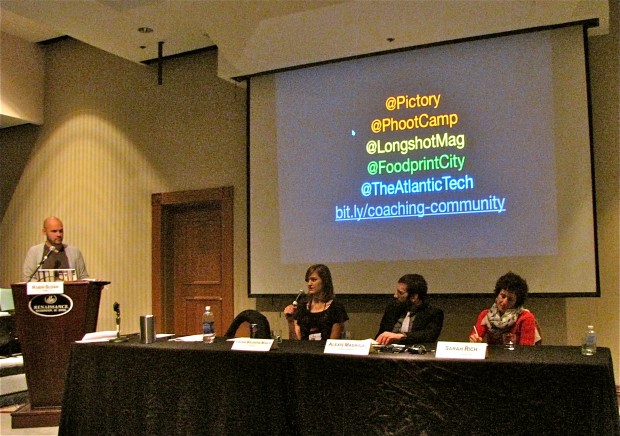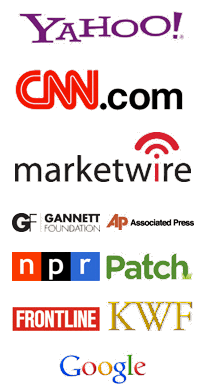
Robin Sloan of Twitter introduces the panelists, from left to right: Laura Brunow Miner of Pictory, and Alexis Madrigal and Sarah Rich, both of Longshot Magazine. Photo by Heather Hodder
At “Don’t Call it UGC,” panelists shared advice for journalists who seek to produce quality work through crowdsourcing.
Laura Brunow Miner, founder of Pictorymag and the quickly expanding Phootcamp, joined Alexis Madrigal and Sarah Rich, co-founders of
Longshot Magazine, to talk strategy for how their projects have been able to publish high quality content from online submissions.
“Finesse, hard work and respect are the three words to keep in mind and walk away with from this panel,” said Robin Sloan, who works on media partnerships at Twitter. “They’re not tech words but craft words. Crowdsourcing is a skill you can learn.”
Panelists asserted that User Generated Content (UGC) is misleading because it implies inferior quality work; content for Longshot and Pictory is carefully edited and fact-checked similar to traditional publications. Instead, panelists preferred the term “community editorials” to convey the craftsmanship they say is innate within crowdsourcing.
“With UGC more often there’s terror about opening the floodgates to send a lot of crap in. What we’re doing is different, our content comes through a very fine filter,” said Sarah Rich, former senior editor for Dwell Magazine.
Longshot is a magazine that is created over only 48 hours, with the theme announced right before the clock starts ticking. Submissions are accepted only within the first 24 hours, and in the next 24 the magazine is edited, compiled and made available for purchase online. The contributors are paid, but through “socialism” and “meritocracy” as explained by Longshot’s website.
One-third of the profits from the first 48 days of the magazine’s sale are divided evenly among contributors and staff. However contributors and staff vote on all of the published content, and the contributor whose piece comes in first gets the second third of profits. The remaining third of the profits goes toward future publication efforts.
For the majority of the contributions to the magazine, it’s not big bucks. For the first issue, the average contributor was paid $8.93, Rich said.
With little compensation, and none at all for contributors to Pictory, all of the panelists agreed that there is something stronger behind community motivation.
“It gives people exposure, and a chance to vent emotionally. If you need convincing, look at Post Secret …people find it cathartic,” Brunow Miner said. Her site pictorymag.com displays weekly photo showcases connected by a theme. Anyone from around the world can submit a photo along with a caption, and photos are chosen based on how the theme was interpreted. “I look for photos that tell a story,” Brunow Miner said.
Of course there are difficulties in producing community editorials, such as finding a way to connect a seemingly disjointed staff of strangers.
“Voice is wrapped up in a lot of ways, and there is often assumption you sacrifice voice [through crowdsourcing]. How do you make sure voice is behind all of it?” Sloan asked.
“A great edit is the secret to community editorials,” said Brunow Miner ” I do line edits–highlighting words that I think are important helps it become cohesive–and I e-mail them back to my contributors for changes.”
Editors show respect for contributors’ work so that contributors will submit again. Pictory gains respect from contributors by letting them check edits before publication, and Longshot magazine instructs those whose submissions aren’t chosen to publish them on their own blogs, and then Longshot usually links to them.
All of the panelists have a strong presence on Twitter, where much marketing takes place. You can follow them at @pictory or @longshotmag.
